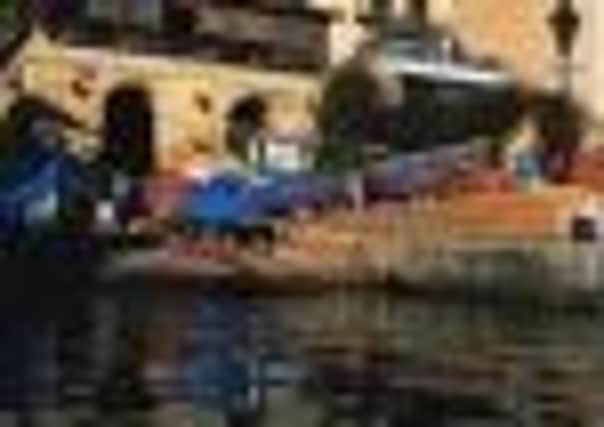Days and knights


Sitting on the shaded roof of a rustic farmhouse sipping a delicious array of crisp whites and sumptuous reds, I peered out into the endless sea of sun-kissed grapevines surrounding me. The picturesque 19-hectare vineyard could easily have been mistaken for one in Tuscany. In fact it was a former RAF airfield.
Britain’s 150-year occupation was onlythe most recent of many. The island, within a three-hour flight of the UK, is a melting pot of history, art and architecture, influenced by the many cultures imposed on its rocky shores over 7,000 years.
Advertisement
Hide AdAdvertisement
Hide AdThe bustling town of St Julian’s on the eastern coast is a lively hub of hotels, restaurants, bars, shops and casinos five miles from the capital Valetta, a fortified city built in the mid-16th century by the Knights of St John – arguably the most influential group to have settled on the island. In 1530, after being chased out of Rhodes by the Ottomans, Charles V of Spain allowed the Knights to base themselves in Malta in return for religious devotion and the annual rent of just one falcon. The Knights remained here until 1798.
My guide Audrey, who like all the Maltese spoke perfect English, led me into Valetta, which is flanked on three sides by the sparkling sea and, with a population of just over 6,000, is Europe’s smallest capital. The morning sun lit up the ornate facades and enclosed painted balconies of the golden limestone villas which tower over the wide cobbled streets.
Home to 320 monuments, including grand cathedrals, opulent churches, statues, fountains and palaces, Valetta resembles an open-air museum and is one of nine World Heritage sites to grace Malta. It also boasts a host of high-end boutiques, alfresco cafes and restaurants, with a peppering of British post boxes, red phone kiosks and even a branch of Marks and Spencer serving as a reminder of the island’s colonial influences.
St John’s Co-Cathedral is a Baroque gem whose guarded oratory houses two original masterpieces by Caravaggio including his largest-ever work, the spine-tingling Beheading of John the Baptist. He came to Malta and painted for free in exchange for his induction into the Knights’ Order, which today includes the likes of Sir Cliff Richard. The Grandmaster’s Palace in George’s Square is decorated with beautiful frescoes depicting scenes from the Great Siege, while suits of armour used by the Knights line the corridors.
Advertisement
Hide AdAdvertisement
Hide AdAfter enjoying a frothing cappuccino and ice cream at Caffe Cordina in the shaded confines of Republic Square, we made our way to Upper Barracca Gardens, the highest point of the city walls. Fountains trickled in the background and I took in the views of Malta’s Grand Harbour, the largest natural harbour in the Med, a Royal Navy base until 1979 when Malta became a republic.
Audrey suggested we took a tour in a disa – similar to a gondola – for a closer look at the towering coralline walls of Fort St Angelo and the three cities of Vittoriosa, Cospicua and Senglea, which straddle the harbour. As we took to the blue waters, she reeled off a list of Hollywood blockbusters including Gladiator, Troy and The Count Of Monte Cristo, which have made use of the harbour’s epic beauty.
At Vittoriosa, the Knights’ original capital we stopped for a lunch of mussels and fresh lampuka – a sweet-tasting local fish – at the idyllic waterfront restaurant Riviera della Marina.
Touring the medieval walled citadel of Mdina, home to the National Museum of Natural History, palaces of past Grand Masters and the Bishop’s Cathedral, I could see why it is nicknamed “The Silent City”. With a population of just 200, only the cars of the residents are allowed.
Advertisement
Hide AdAdvertisement
Hide AdI also trod the grand marble staircases and walled gardens of the Palazzo Parisio – described by many as a miniature Versailles – a stately home in the ancient village of Naxxar built in the 1800s.
The most exhilarating part of my trip came as I whizzed along the cliff tops of Dingli on a Segway – one of the best ways to see the island’s countryside. I was treated to glorious views of the west coast and the tiny uninhabited island of Filfla, used for bombing practice by the RAF.
The mostly rocky island also has a handful of idyllic beaches to the north, with Golden Bay and Gnejna the best on offer. A greater variety is found on Gozo, Malta’s sister island, only a 20-minute ferry ride away and blessed with stunning natural wonders including Calypso’s Cave which overlooks the red sands of Ramla Bay and the Azure Window, a giant doorway of rock surrounded by deep blue sea.
Getting there: Tom Lawrence was a guest of Malta Direct, which offers seven nights’ B&B in late May with deluxe marina view at The Hilton, St Julian’s, from £684, including Easyjet flights from Manchester. Reservations: 0845 365 3410 or www.malta direct.com. The operator flies from 13 airports with easyJet, Thomas Cook, Thomson, bmibaby and Air Malta.